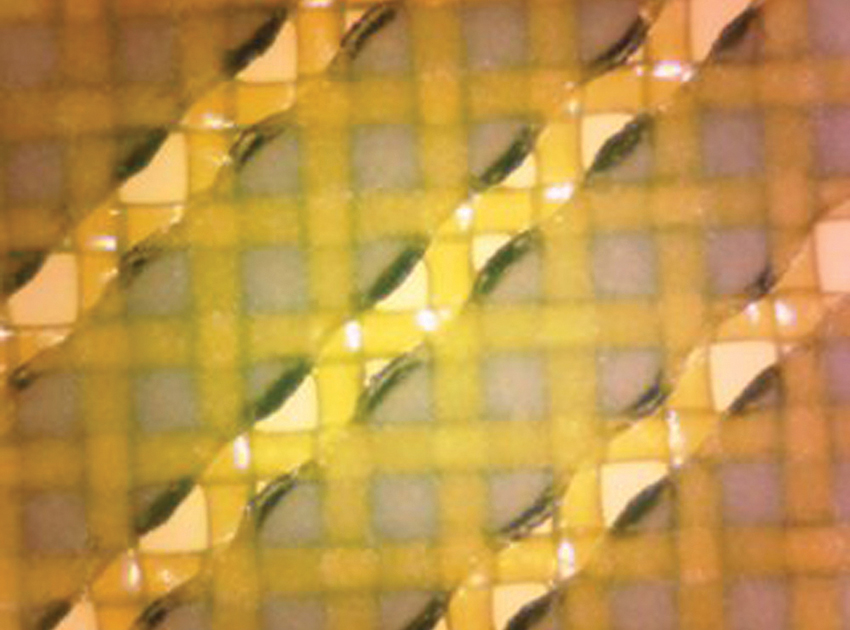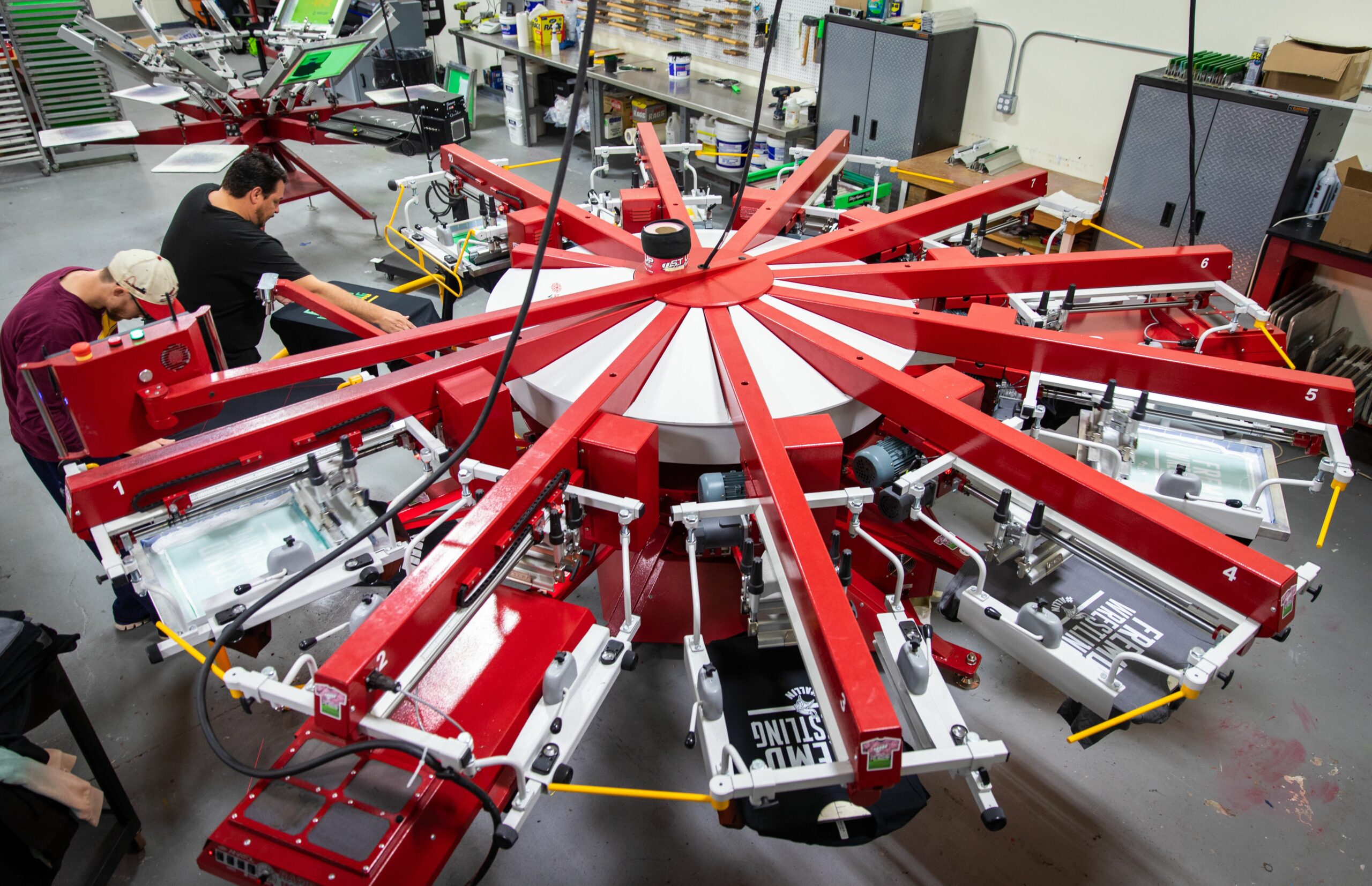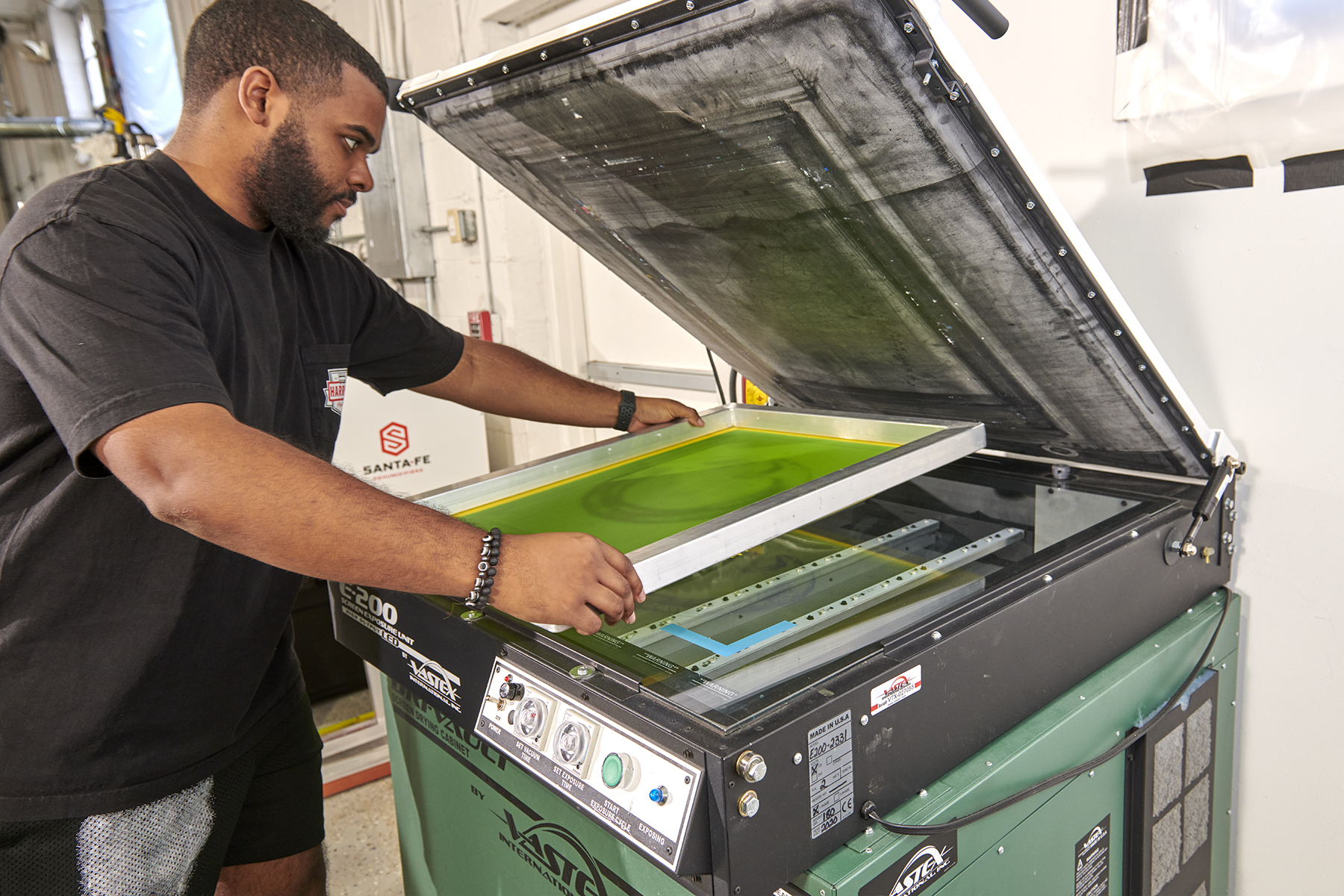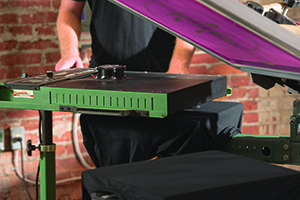October 5, 2017
Digital computer-to-screen (CTS) imaging and LED-exposure technologies have brought much advancement to the screen-printing industry and, with it, confusion about screen- imaging and exposing choices.
With new CTS systems and the surge in LED-exposure equipment, printers have many exciting screen-making options for imaging and exposing screens. The following is a clarification of the variety of equipment available, as well as the emulsions best suited for them.
CTS imaging includes all technologies that image a screen directly from a digital file without film positives. Two technologies currently are used: inkjet masking and digital direct exposure. CTS systems save time and money that once were spent outputting, cutting, tagging, transporting, repairing and storing film positives by reproducing art directly onto coated screens.
Exposure glass and vacuum frames are no longer needed. Therefore, time isn’t spent cleaning film positives and vacuum-frame glass, or waiting for the vacuum to draw down. As a result, pinholes are greatly diminished. Even exposure times are shortened by as much as 40% because the combination of exposure glass and film positive blocks about 40% of the ultraviolet (UV) light.
CTS imaging systems can be grouped into two categories — masked (inkjet) and maskless (direct-light exposure) — and then subdivided by their basic structures. Masked systems use inkjet technology to apply ink onto a coated screen, forming the UV mask traditionally created by opaque film positives, and are equipped with either water- or wax-based heads. Maskless systems do not use a mask, but instead image and expose in one step. A digital light processor (DLP) traverses a coated screen’s surface, exposing only the negative image. This allows the positive image to washout in developing.
Maskless systems are available with either conventional UV, LED or laser light sources. The two primary systems in North America are conventional UV and LED exposure lamps. These systems are predominately used by graphic printers, but smaller units are beginning to make some inroads into the transfer- and
garment-printing markets in Mexico and Central America.
Exposure System Choices
Exposure systems also can be divided into two categories — static and dynamic — and further subdivided into single-point and multipoint systems.
Static: In static (stationary) exposure systems, the light source and screen remain stationary as the entire screen or multiple screens are exposed. These systems allow for the widest variety of emulsion choices and are available in single-point or multipoint configurations.
Dynamic: With dynamic (moving) exposure systems, either the light source moves across a stationary screen or the screen moves underneath a stationary light source. Each part of the screen is momentarily exposed to light. They rely on their close proximity to the screen to cure the emulsion and are limited to fast-exposing SBQ emulsions. Dynamic systems also are available in single-point or multipoint configurations.
Single-Point: Single-point light sources use a single bulb or light column. Static single-point systems require sufficient distance from the screen to achieve uniform coverage. Some UV energy reduction at the perimeter of the exposure area occurs, as light must travel farther to reach these outer areas. UV falloff is minimized through the use of reflectors that redirect stray light toward the perimeter areas, and by establishing the correct distance between the light and screen. Single-point lights are available as static (conventional metal-halide light sources) or dynamic (maskless direct-light exposure) systems.
Multipoint: Also available in static or dynamic configurations, multipoint light sources use multiple florescent tubes or arrays of LEDs matching the screen’s width and length when provided in a static configuration. Or they match only the screen’s width when provided in a dynamic configuration. While multipoint light sources typically provide better light uniformity than single-point systems, light scatters more than with single-point systems, causing light undercutting of the artwork.
LED Emulsion Curing
LED systems come in many styles and configurations, and are available in each of the four aforementioned categories. They generally offer the following:
• Exposure speeds that match those of high-wattage, metal-halide systems (primarily with SBQ emulsions) and surpass those of all low-wattage light sources;
• Low power consumption;
• Much longer bulb life than metal-halide bulbs;
• More efficiency, producing much less heat.
Exposure rooms and vacuum-frame glass remain cooler, which helps maintain the dimensional stability of film positives, and prevents films and emulsions from sticking to the glass. Unlike the broad spectrum of UV light that metal-halide bulbs emit, LEDs emit a narrow band near a single wavelength (e.g., 405 nanometers). To provide better UV breadth, some systems incorporate two or three different LED wavelengths.
As demand for CTS systems with integrated exposure increases, so does the demand for faster-exposing emulsions. Those once considered fast on static light sources now are considered slow on dynamic exposure systems.
Re-Examining Emulsion Choices
With many different types of imaging and exposing systems on the market, and as ink systems continue to evolve, many printers now wonder what is best for their systems. The answer depends on many factors, including ink type and cleanup solvents used, artwork complexity, job size, and level of stencil control and consistency. Selecting the best emulsion requires a basic understanding of the available types.
There are four primary categories of emulsions: diazo, diazo-photopolymer, SBQ and SBQ-photopolymer. They can be classified by the type of sensitizer (diazo or SBQ) and the number of light-sensitized curable components — single cure (one) or dual cure (two).
Diazo emulsions come with a small bottle of powder (sometimes syrup) that typically is dissolved in water and mixed into the emulsion. SBQ emulsions also come in single- and dual-cure formulations.
Dual cures (both diazo and SBQ) contain UV-curable resin; single cures (both diazo and SBQ) do not. Also, dual cures are capable of dual resistance (solvent and water), while single cures are not. The latter provides single resistance to either solvent or water, but not both.
Garment printers traditionally used single-cure emulsions offering only single resistance, but now they use inks that may require both water and solvent resistance. Most high-solids acrylics contain both water and solvent, so a dual-resistant, dual-cure emulsion is the best choice for these inks.
Furthermore, some plasticizers used in new eco-friendly plastisol inks require greater solvent resistance than currently is provided by some single-cure emulsions, so a dual-cure emulsion will be more compatible.
The consumer trend is toward SBQ dual-cure emulsions because they expose much faster than diazo dual cures, meaning they can handle the demand for faster throughput associated with CTS equipment with integrated exposure systems. Dual-cure SBQs typically have better copying properties and chemical resistance compared to single-cure SBQs.
While dual-cure SBQs sometimes are called hybrids, a better definition of a hybrid emulsion may be an SBQ emulsion to which diazo sensitizer is added.
Both diazo-style emulsions require mixing and four to eight times longer exposure times than most SBQ-style emulsions, and have a four- to six-week pot life after mixing.
Conversely, both SBQ-style emulsions require no mixing, are the fastest-exposing emulsions available, and have a shelf and pot life of 12-18 months. Typically, both dual-cure varieties have better copying properties, exposure latitude and chemical resistance than single-cure varieties.
Today’s printers have myriad screen-making equipment options, as well as a multitude of emulsion choices. Developing an understanding of the fundamental principles of screen making and instituting tighter control of key variables will enable printers to incorporate these new technologies while preventing mishaps along the way.
Dave Dennings is technical product manager of screen-making products for KIWO Inc., where he oversees product development and the company’s applications laboratory. He has worked in the screen-printing industry for 30 years, has served in technical sales positions with KIWO and Sefar, and was inducted into the Academy of Screen and Digital Printing Technologies (ASDPT) in 2006. He can be reached at daved@kiwo.com.
Exposure Latitude
Exposure latitude relates to an emulsion’s tolerance for longer or shorter-than-optimum UV exposure duration and varies considerably among the four emulsion types. Those with wide exposure latitude, as exhibited by diazo-
photopolymer and diazo emulsions, provide greater processing latitude.
Fast-exposing SBQ emulsions exhibit narrow exposure latitude, thus requiring tighter control of coating thickness, which affects proper exposure time proportionally.
There is a significant difference in exposure speed between SBQ and diazo-style emulsions. Keep in mind that what is gained in speed is lost in exposure latitude and, often, resolution and resistance.
CTS Imaging System Types & Attributes
Masked (Inkjet) Systems:
• Lower initial cost
• Additional consumable cost of the ink or wax
• Resolution up to 1,200 dpi
• Primary market: T-shirt and small-format graphic printers
• Larger choice of emulsion options when used with static (stationary) exposure systems
Maskless (Direct-Light Exposure) Systems:
• Higher initial cost
• Do not require ink or wax consumables
• Resolution up to 2,540 dpi
• Primary market: medium- to large-format graphic printers
• Typically requires ultra-fast exposing emulsions to meet throughput expectations
March 20, 2024 | Production
As with pretty much any business, one of the keys for apparel and T-shirt decorators running a successful custom screen-printing shop is having the right equipment, first and foremost, the right press, or presses.
FULL STORY
March 15, 2024 | Production
As is the case with flash units and dryers, screen exposure units, computer-to-screen-systems and washout booths are critical to successful screen printing of T-shirts and other apparel
FULL STORY
January 16, 2024 | Production
Go to any industry trade show or visit an actual custom apparel screen-printing shop, and your eyes will naturally be drawn to the press, or presses there. This is true whether the shop in question employs a single manual press or is running multiple autos.
FULL STORY




